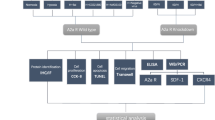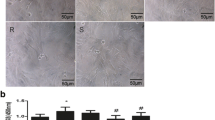Abstract
Objective
This study aimed to investigate the effects of the peroxisome proliferator-activated receptor δ (PPARδ) agonist GW501516 on the proliferation of pulmonary artery smooth muscle cells (PASMCs) induced by hypoxia, in order to search for new drugs for the treatment and prevention of pulmonary vascular remodeling.
Methods
PASMCs were incubated with different concentrations of GW501516 (10, 30, 100 nmol/L) under the hypoxic condition. The proliferation was determined by a CCK-8 assay. The cell cycle progression was analyzed by flow cytometry. The expression of PPARδ, S phase kinase-associated protein 2 (Skp2), and cell cycle-dependent kinase inhibitor p27 was detected by Western blotting. Then PASMCs were treated with 100 nmol/ L GW501516, 100 nmol/L mammalian target of rapamycin (mTOR) inhibitor rapamycin and/or 2 µmol/L mTOR activator MHY1485 to explore the molecular mechanisms by which GW501516 reduces the proliferation of PASMCs.
Results
The presented data demonstrated that hypoxia reduced the expression of PPARδ in an oxygen concentration- and time-dependent manner, and GW501516 decreased the proliferation of PASMCs induced by hypoxia by blocking the progression through the G0/G1 to S phase of the cell cycle. In accordance with these findings, GW501516 downregulated Skp2 and upregulated p27 in hypoxia-exposed PASMCs. Further experiments showed that rapamycin had similar effects as GW501516 in inhibiting cell proliferation, arresting the cell cycle, regulating the expression of Skp2 and p27, and inactivating mTOR in hypoxia-exposed PASMCs. Moreover, MHY1485 reversed all the beneficial effects of GW501516 on hypoxia-stimulated PASMCs.
Conclusion
GW501516 inhibited the proliferation of PASMCs induced by hypoxia through blocking the mTOR/Skp2/p27 signaling pathway.
Similar content being viewed by others
References
Chai T, Qiu C, Xian Z, et al. A narrative review of research advances in hypoxic pulmonary hypertension. Ann Transl Med, 2022,10(4):230
Li C, Zhu H, Zhang S, et al. Astragaloside IV ameliorates pulmonary vascular remodeling in hypoxia-induced pulmonary hypertension by restraining the T follicular helper cell response and expanding T follicular regulatory cell response. Phytomedicine, 2022,102:154171
Rajagopal S, Yu YA. The Pathobiology of Pulmonary Arterial Hypertension. Cardiol Clin, 2022,40(1):1–12
Hu HH, Zhang RF, Dong LL, et al. Overexpression of ACE2 prevents hypoxia-induced pulmonary hypertension in rats by inhibiting proliferation and immigration of PASMCs. Eur Rev Med Pharmacol Sci, 2020,24(7):3968–3980
Liu Y, Nie X, Zhu J, et al. NDUFA4L2 in smooth muscle promotes vascular remodeling in hypoxic pulmonary arterial hypertension. J Cell Mol Med, 2021,25(2):1221–1237
Wang AP, Yang F, Tian Y, et al. Pulmonary Artery Smooth Muscle Cell Senescence Promotes the Proliferation of PASMCs by Paracrine IL-6 in Hypoxia-Induced Pulmonary Hypertension. Front Physiol, 2021,12:656139
Liu X, Wang G, You Z, et al. Inhibition of hypoxia induced proliferation of pulmonary arterial smooth muscle cells by a mTOR siRNA-loaded cyclodextrin nanovector. Biomaterials, 2014,35:4401–4416
Zha LH, Zhou J, Tan Y, et al. NLRC3 inhibits PDGF-induced PASMCs proliferation via PI3K-mTOR pathway. J Cell Physiol, 2020,235(12):9557–9567
Krymskaya VP, Snow J, Cesarone G, et al. mTOR is required for pulmonary arterial vascular smooth muscle cell proliferation under chronic hypoxia. FASEB J, 2011,25(6):1922–1933
Song Y, Wu Y, Su X, et al. Activation of AMPK inhibits PDGF-induced pulmonary arterial smooth muscle cells proliferation and its potential mechanisms. Pharmacol Res, 2016,107:117–124
Ke R, Liu L, Zhu Y, et al. Knockdown of AMPKα2 Promotes Pulmonary Arterial Smooth Muscle Cells Proliferation via mTOR/Skp2/p27(Kip1) Signaling Pathway. Int J Mol Sci, 2016,17(6):844
Degueurce G, D’Errico I, Pich C, et al. Identification of a novel PPARbeta/delta/miR-21-3p axis in UV-induced skin inflammation. EMBO Mol Med, 2016,8(8):919–936
Cheang WS, Wong WT, Zhao L, et al. PPARδ Is Required for Exercise to Attenuate Endoplasmic Reticulum Stress and Endothelial Dysfunction in Diabetic Mice. Diabetes, 2017,66(2):519–528
Kintz P, Ameline A, Gheddar L, et al. Testing for G W501516 (cardarine) in human hair using LC/MS-MS and confirmation by LC/HRMS. Drug Test Anal, 2020,12(7):980–986
Weihrauch M, Handschin C. Pharmacological targeting of exercise adaptations in skeletal muscle: Benefits and pitfalls. Biochem Pharmacol, 2018,147:211–220
Hwang JS, Ham SA, Yoo T, et al. Sirtuin 1 Mediates the Actions of Peroxisome Proliferator-Activated Receptor δ on the Oxidized Low-Density Lipoprotein–Triggered Migration and Proliferation of Vascular Smooth Muscle Cells. Mol Pharmacol, 2016,90(5):522–529
Kang ES, Hwang JS, Lee WJ, et al. Ligand-activated PPARdelta inhibits angiotensin II-stimulated hypertrophy of vascular smooth muscle cells by targeting ROS. PLoS One, 2019,14(1):e0210482
Zhang S, Wang J, Qi X, et al. Plasminogen activator Inhibitor-2 inhibits pulmonary arterial smooth muscle cell proliferation in pulmonary arterial hypertension via PI3K/Akt and ERK signaling. Exp Cell Res, 2021,398(1):112392
Chen C, Tang Y, Deng W, et al. Salidroside blocks the proliferation of pulmonary artery smooth muscle cells induced by platelet derived growth factor BB. Mol Med Rep, 2014,10(2):917–922
Gui D, Cui Z, Zhang L, et al. Salidroside attenuates hypoxia-induced pulmonary arterial smooth muscle cell proliferation and apoptosis resistance by upregulating autophagy through the AMPK-mTOR-ULK1 pathway. BMC Pulm Med, 2017,17(1):191
Jeong K, Murphy JM, Ahn EE, et al. FAK in the nucleus prevents VSMC proliferation by promoting p27 and p21 expression via Skp2 degradation. Cardiovasc Res, 2022,118(4):1150–1163
Liu L, Pan Y, Song Y, et al. Activation of AMPK α2 inhibits airway smooth muscle cells proliferation. Eur J Pharmacol, 2016,791:235–243
Parikh V, Bhardwaj A, Nair A. Pharmacotherapy for pulmonary arterial hypertension. J Thorac Dis, 2019,11(Suppl 14):S1767–S1781
Deng H, Tian X, Sun H, et al. Calpain-1 mediates vascular remodelling and fibrosis via HIF-lα in hypoxia-induced pulmonary hypertension. J Cell Mol Med, 2022,26(10):2819–2830
Nan X, Yang Z, Su S, et al. The Mechanism of Volatile Oil of Rhodiola tangutica against Hypoxia-Induced Pulmonary Hypertension in Rats Based on RAS Pathway. Biomed Res Int, 2022,2022:9650650
Tian D, Teng X, Jin S, et al. Endogenous hydrogen sulfide improves vascular remodeling through PPARdelta/ SOCS3 signaling. J Adv Res, 2020,27:115–125
Hytönen J, Leppänen O, Braesen JH, et al. Activation of Peroxisome Proliferator-Activated Receptor-delta as Novel Therapeutic Strategy to Prevent In-Stent Restenosis and Stent Thrombosis. Arterioscler Thromb Vasc Biol, 2016,36(8):1534–1548
Fouty BW, Grimison B, Fagan KA, et al. p27(Kip1) is important in modulating pulmonary artery smooth musclecell proliferation. Am J Respir Cell Mol Biol, 2001,25(5):652–658
Chen MJ, Cheng AC, Lee MF, et al. Simvastatin induces G(1) arrest by up-regulating GSK3β and down-regulating CDK4/cyclin D1 and CDK2/cyclin E1 in human primary colorectal cancer cells. J Cell Physiol, 2018,233(6):4618–4625
Luan L, Li N, Zhang K, et al. Diversin upregulates the proliferative ability of colorectal cancer by inducing cell cycle proteins. Exp Mol Pathol, 2023,129:104850
Fujita T, Liu W, Doihara H, et al. Regulation of Skp2-p27 axis by the Cdh1/anaphase-promoting complex pathway. Am J Pathol, 2008,173(1):217–228
Zhang H, Gong Y, Wang Z, et al. Apelin inhibits the proliferation and migration of rat PASMCs via the activation of PI3K/Akt/mTOR signal and the inhibition of autophagy under hypoxia. J Cell Mol Med, 2014,18(3):542–553
Author information
Authors and Affiliations
Corresponding author
Ethics declarations
The authors declare that there is no conflict of interest with any financial organization or corporation or individual that can inappropriately influence this work.
Additional information
This study was supported by the National Natural Science Foundation of Hubei Province (No. 2018CFC801).
Rights and permissions
About this article
Cite this article
Chen, Cg., Yi, Cf., Chen, Cf. et al. Inhibitory Effect of PPARδ Agonist GW501516 on Proliferation of Hypoxia-induced Pulmonary Arterial Smooth Muscle Cells by Regulating the mTOR Pathway. CURR MED SCI 43, 979–987 (2023). https://doi.org/10.1007/s11596-023-2757-y
Received:
Accepted:
Published:
Issue Date:
DOI: https://doi.org/10.1007/s11596-023-2757-y




